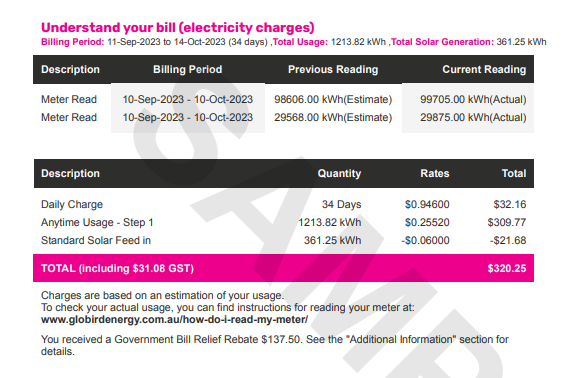If you’re like many Aussies who scratch their heads when trying to decipher your energy bill, you’re not alone. Although the jargon listed on your electricity bill can be confusing, it’s important to understand the type of tariff you are on.
Your tariff is one of the key components that impacts the price you pay for electricity. In a nutshell, there are three main types of electricity tariffs: single rate, time of use and controlled load. This Canstar Blue article unpacks everything you need to know about single rate tariffs, and explores how they stack up against the others.
On this page, you’ll find:
What is a single rate tariff?
Also known as a ‘peak’, ‘anytime’ or ‘general usage’ rate, a single rate tariff is a type of pricing structure offered by energy retailers that has no peak or off-peak time periods. This means you pay the same price for electricity irrespective of the time of day. Single rate tariffs vary between different energy distribution networks.
Like all tariffs, a single rate tariff is comprised of two parts:
- Usage charge – for the amount of electricity used, charged in cents per kilowatt hour (kWh).
- Daily supply charge – for connection to the electricity network.
Generally, a single rate tariff is cheaper than the ‘peak’ rates on a time of use tariff, which is great if you use most of your energy during peak periods, such as weeknights. A single rate tariff is the simplest type of tariff and is available regardless of your meter type.
Single rate tariff on your bill
The below example is a sample bill from GloBird Energy for a household with a single rate tariff, along with a solar feed-in tariff. Be aware that in this example it displays the single rate tariff as ‘anytime usage’. Factoring in daily supply charges and the solar feed-in tariff discount, this bill shows a total usage cost of $320.25 for the period.

Compare single rate plans
Here are some of the cheapest published deals from the retailers on our database that include a link to the retailer’s website for further details. These are products from referral partners†. These costs are based on the Ausgrid network in Sydney but prices may vary depending on your circumstances. This comparison assumes general energy usage of 3900kWh/year for a residential customer on a single rate tariff. Please use our comparison tool for a specific comparison in your area. Our database may not cover all deals in your area. As always, check all details of any plan directly with the retailer before making a purchase decision.
Here are some of the cheapest published deals from the retailers on our database that include a link to the retailer’s website for further details. These are products from referral partners†. These costs are based on the Citipower network in Melbourne but prices may vary depending on your circumstances. This comparison assumes general energy usage of 4000kWh/year for a residential customer on a single rate tariff. Please use our comparison tool for a specific comparison in your area. Our database may not cover all deals in your area. As always, check all details of any plan directly with the retailer before making a purchase decision.
Here are some of the cheapest published deals from the retailers on our database that include a link to the retailer’s website for further details. These are products from referral partners†. These costs are based on the Energex network in Brisbane but prices may vary depending on your circumstances. This comparison assumes general energy usage of 4600kWh/year for a residential customer on a single rate tariff. Please use our comparison tool for a specific comparison in your area. Our database may not cover all deals in your area. As always, check all details of any plan directly with the retailer before making a purchase decision.
Here are some of the cheapest published deals from the retailers on our database that include a link to the retailer’s website for further details. These are products from referral partners†. These costs are based on the SA Power network in Adelaide but prices may vary depending on your circumstances. This comparison assumes general energy usage of 4000kWh/year for a residential customer on a single rate tariff. Please use our comparison tool for a specific comparison in your area. Our database may not cover all deals in your area. As always, check all details of any plan directly with the retailer before making a purchase decision.
What is the cheapest electricity tariff?
Although tariffs have a big impact on your overall energy costs, it’s important to look at other features of your plan, such as whether you’re on a standard or market offer, and if the energy retailer provides pay on time discounts or other sign-up incentives. Ultimately, the ‘cheapest’ tariff will depend on a variety of circumstances, including:
- Times when you use the most energy (i.e. weeknights or weekends).
- Types of household appliances you use and when (e.g. dishwasher between 10pm and midnight).
- If you want to take advantage of ‘peak’ and ‘off-peak’ times, provided you have a smart meter.
- If you have large appliances like a pool pump or underfloor heating that require controlled load tariffs.
If you’d like to know how to find an energy plan with great value in your state, click on the links below. Otherwise you use the Canstar Blue comparison tool and enter your postcode for a specific quote in your area.
What other types of electricity tariffs are there?
Aside from single rate tariffs, there are a range of other electricity tariffs you may have access to, including:
- Time of use tariff: A different usage rate applies depending on the time of day (i.e. cheapest rates are late at night and early morning).
- Block rate: Price of electricity varies with each daily or quarterly ‘block’ of energy usage, usually the only tariff available for gas customers.
- Controlled load: Designed for large household appliances such as hot-water systems that are metered separately. Electricity prices are generally lower. However, electricity is only supplied during off-peak hours.
- Feed-in tariff: Receive small credits for electricity that solar systems export back into the electricity grid.
Some energy tariffs won’t be available in all states or accessible through every energy retailer and some tariffs require a smart meter. If you’d like to learn more about electricity tariffs available in your state, click on the guides below:
Is a single rate tariff right for you?
A single rate tariff could be a suitable option if you consume most of your energy during busier periods of the day (i.e. weeknights). Given that single rate tariffs are generally charged at a cheaper rate than the peak rates of other tariffs, you could save money on your overall energy costs.
However, if you want to take advantage of shoulder or off-peak rates, you may be better suited on a time of use tariff, provided you have a smart meter. Keep in mind that all electricity providers offer single rate tariffs regardless of where you live.
Original reporting by Dean Hechscher
Image Source: Yelantsevv/Shutterstock



Share this article